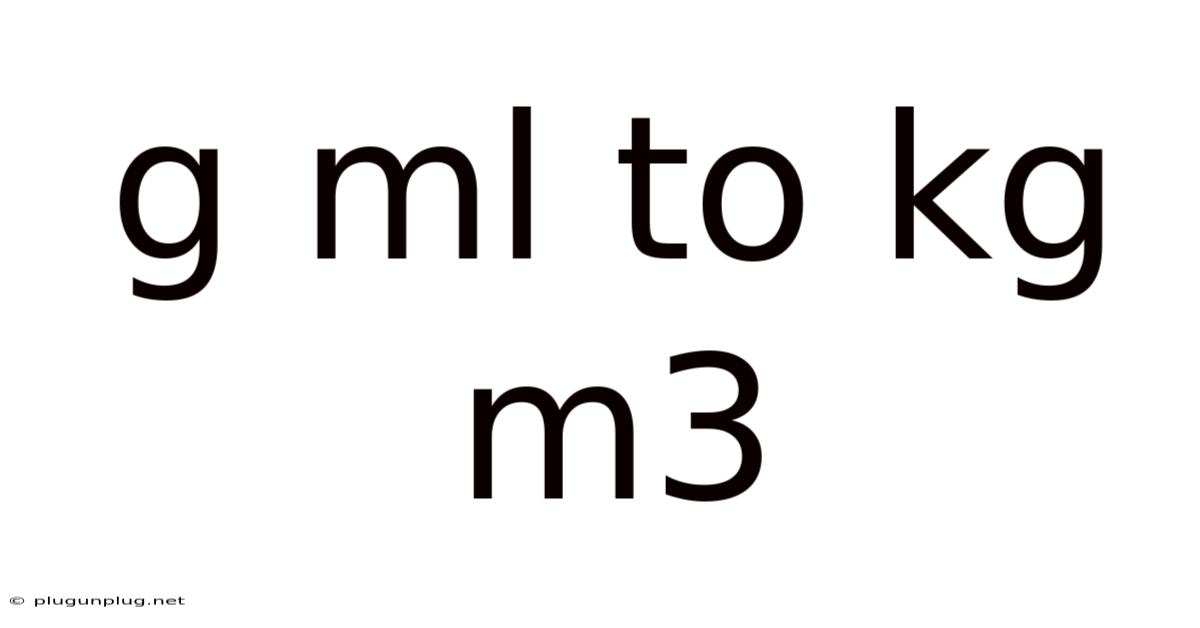G Ml To Kg M3
plugunplug
Sep 23, 2025 · 5 min read

Table of Contents
Converting Grams per Milliliter (g/mL) to Kilograms per Cubic Meter (kg/m³): A Comprehensive Guide
Understanding unit conversions is crucial in various scientific and engineering fields. This article provides a comprehensive guide on converting grams per milliliter (g/mL), a common unit of density, to kilograms per cubic meter (kg/m³), the SI unit for density. We'll explore the conversion process, delve into the underlying principles, and address frequently asked questions to solidify your understanding. This guide is designed for students, researchers, and anyone needing a clear and concise explanation of this vital conversion.
Introduction: Understanding Density and Units
Density is a fundamental physical property that describes the mass of a substance per unit volume. It's often expressed in units like grams per milliliter (g/mL) or kilograms per cubic meter (kg/m³). While both units measure density, they differ in their scale. g/mL is commonly used in laboratory settings and for smaller volumes, whereas kg/m³ is the standard SI unit, preferred for larger-scale applications and calculations. Mastering the conversion between these two units is essential for consistent and accurate scientific work.
The Conversion Process: From g/mL to kg/m³
The conversion from g/mL to kg/m³ involves considering the relationship between grams and kilograms, and milliliters and cubic meters. Here's a step-by-step breakdown:
-
Grams to Kilograms: There are 1000 grams in 1 kilogram (1 kg = 1000 g). Therefore, to convert grams to kilograms, we divide the value in grams by 1000.
-
Milliliters to Cubic Meters: This step requires a slightly more nuanced approach. Recall that 1 milliliter (mL) is equal to 1 cubic centimeter (cm³). Further, 1 meter (m) is equal to 100 centimeters (cm). Therefore, 1 cubic meter (m³) is equivalent to (100 cm)³ = 1,000,000 cm³ = 1,000,000 mL. To convert milliliters to cubic meters, we divide the value in milliliters by 1,000,000.
-
Combining the Conversions: To convert g/mL to kg/m³, we combine the above two steps. We divide the value in grams by 1000 (to convert to kilograms) and multiply the resulting value by 1,000,000 (to convert milliliters to cubic meters). Alternatively, we can simply multiply the g/mL value by 1000.
Mathematical Formula:
The conversion can be summarized by the following formula:
Density (kg/m³) = Density (g/mL) * 1000
This formula simplifies the conversion process significantly. Let's illustrate with an example.
Example Conversion:
Let's say we have a substance with a density of 1.5 g/mL. To convert this to kg/m³:
Density (kg/m³) = 1.5 g/mL * 1000 = 1500 kg/m³
Therefore, a substance with a density of 1.5 g/mL has a density of 1500 kg/m³.
Detailed Explanation of the Conversion Factors:
The conversion factor of 1000 arises from the combined effect of the metric system's prefixes. Let's break it down further:
-
kilo (k): The prefix "kilo" represents 1000. Therefore, 1 kg = 1000 g.
-
milli (m): The prefix "milli" represents 1/1000. Therefore, 1 mL = 1/1000 L = 1 cm³. Cubing this relationship (because we're dealing with volume), we get (1 cm)³ = 1 cm³.
-
Combining Prefixes: The combined effect of converting grams to kilograms and milliliters to cubic meters results in a factor of 1000. Since 1 mL = 1 cm³ and 1 m = 100 cm, then 1 m³ = (100 cm)³ = 1,000,000 cm³ = 1,000,000 mL. The conversion from g/mL to kg/m³ therefore involves dividing by 1/1000 (for g to kg) and multiplying by 1,000,000 (for mL to m³), which simplifies to multiplying by 1000.
Applications of Density Conversions:
Accurate density conversions are crucial in various applications, including:
-
Fluid Mechanics: Calculating pressures and forces in fluids requires knowing the density in consistent units.
-
Material Science: Determining the properties of materials often involves density measurements and comparisons.
-
Chemical Engineering: Many chemical processes depend on the accurate knowledge of reactant and product densities.
-
Environmental Science: Monitoring water quality and pollution levels often involves density measurements.
Frequently Asked Questions (FAQ)
-
Q: Can I convert from kg/m³ to g/mL using the same formula?
A: Yes, you can. Simply divide the density in kg/m³ by 1000 to get the density in g/mL.
-
Q: What if I have a density in a different unit, such as g/cm³?
A: g/cm³ is equivalent to g/mL. Therefore, you can directly apply the conversion formula.
-
Q: Are there any limitations to this conversion?
A: This conversion assumes the density remains constant over the temperature and pressure range. Significant changes in temperature or pressure may affect the density, requiring adjustments to the conversion process.
-
Q: Why is kg/m³ preferred in scientific work?
A: kg/m³ is the SI unit for density. Using SI units ensures consistency and simplifies calculations in international collaborations and scientific publications.
Conclusion: Mastering Unit Conversions for Accurate Results
The conversion from g/mL to kg/m³ is a fundamental skill in many scientific and engineering disciplines. By understanding the underlying principles and applying the simple conversion formula (multiplying by 1000), you can confidently convert between these units, ensuring accuracy and consistency in your calculations. Remember to always consider the potential impact of temperature and pressure on density when performing such conversions. The ability to perform this conversion is essential for anyone working with density measurements and calculations. Mastering this conversion will undoubtedly enhance your problem-solving abilities and accuracy in various scientific and engineering applications.
Latest Posts
Latest Posts
-
Gcf Of 36 And 84
Sep 23, 2025
-
Blood Supply To The Liver
Sep 23, 2025
-
Best Fit Straight Line Excel
Sep 23, 2025
-
How To Calculate Mechanical Advantage
Sep 23, 2025
-
San Diego From La Distance
Sep 23, 2025
Related Post
Thank you for visiting our website which covers about G Ml To Kg M3 . We hope the information provided has been useful to you. Feel free to contact us if you have any questions or need further assistance. See you next time and don't miss to bookmark.